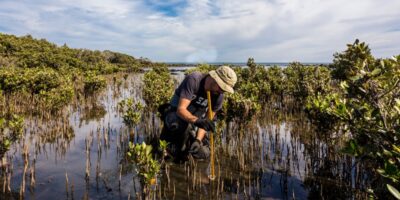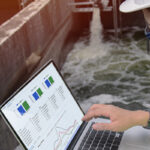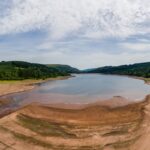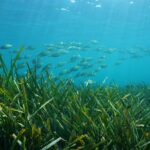Ecosystems play a crucial role in maintaining Earth’s stability by producing oxygen, supplying drinking water and regulating the climate. However, the decline of nature, both on land and in the oceans, is occurring at an unprecedented rate, with approximately one million animal and plant species facing the threat of extinction. The Kunming-Montreal Global Biodiversity Framework, endorsed by world leaders in December 2022, calls for the effective conservation and management of at least 30% of the world’s lands, inland waters, coastal areas and oceans, as well as the restoration of 30% of degraded ecosystems by 2030.
In January 2024, the Global Reporting Initiative (GRI) published a major update to its Biodiversity Standard, which is asking for an ecosystem-based analysis that can be accomplished with a novel tool developed by DHI’s scientists.
In this interview, we talk to DHI’s Global Biodiversity Leads – Lars O. Mortensen, DHI’s Head of Offshore Biodiversity and Verena Schrameyer, Senior Marine Ecologist – on the traditional approaches and recent innovations to measure, compare and manage biodiversity for the benefit of nature.
Q: How is marine biodiversity currently assessed and reported?
Verena: The taxonomic diversity that is currently the centrepiece of biodiversity reporting only considers a fraction of the information that we receive when we are identifying and counting species. Taxonomic diversity literally considers how many species and individuals are present within an ecosystem. There are various indices computing this data to give an indication on species diversity within the ecosystem in focus.
Lars: The current approach of using taxonomic diversity does not consider the effective role of the individual species in the ecosystem that you are monitoring. By adding one more dimension to the information that we have, i.e., the role that the species plays in the ecosystem, we can then assess the ecosystem on a population level and really go into the computation of interrelations and ultimately take a statement on the status of biodiversity.
Biodiversity is a lot more than the number of species and individuals; it should reflect the flow and relationships that are ultimately driving a healthy ecosystem. Stepping away from the ‘species name’ but rather counting individual organisms as the ‘habitat former’ allows for cross-comparison between different habitats and can align biodiversity assessment and valuation methodology in the long run. This is especially crucial when we are trying to combat and reverse global biodiversity loss. There is currently an urgent need for standardising and thereby harmonising the way we are valuating biodiversity.
Q: What is ecosystem-based management and why is it important to use this concept as a benchmark for more accurate reporting?
Verena: Well, ecosystem-based management is a term that is sometimes misused and tends to be applied to a lot more scenarios these days compared to what it was meant to focus on in the first place. An ecosystem-based management in the terms that we are talking about, i.e., the environmental aspect, calls for the acknowledgement of all the different aspects that are contained within an ecosystem. It is not just the key indicator species nor just the growth substrate, it is the presence of living and non-living matter that as a whole characterises an ecosystem. Therefore, true ecosystem-based management aims to capture a holistic view of the ecosystem that is in focus, whether it is for an infrastructure project or a nature restoration project. Applying an ecosystem-based management approach allows us to consider the local conditions specific to the particular ecosystem in focus and can lead to true ‘building with nature’.
Q: A recent article in Singapore’s national newspaper The Straits Times mentioned that DHI has developed a biodiversity metric for the marine environment. Can you tell us more?
Lars: Yes, it was nice to read that DHI is being mentioned as the ones that can resolve biodiversity quantification for the marine environment. The article fostered an outreach of a potential client and we were asked to present our methodology. We explained to them that our tool EBM BioQ is considering of course taxonomic diversity, but we are also computing standard indices to resolve the functional diversity as well as population ecology statistics to reflect the interactions that are driving the ecosystem in focus. These indices and computations are ultimately combined as an EBM BioQ score and are giving it a complex and meaningful backbone, so to say. The client was intrigued that they could resolve the biodiversity assessment as ‘one number’ that can tell the whole story. It can facilitate the reporting and communication of projects and is easy to gauge between monitoring campaigns. This tangible BioQ score is computed based on ecological indices and statistical computations that have been applied in ecological assessments as a standard practice.
It will facilitate the transition from the standard taxonomic diversity to a more complex biodiversity assessment considering the ecosystem as a whole and our clients will always be able to ‘open’ the results for parameters that they are used to communicate.
Q: What you’re saying is essentially, it’s important to have a ‘performance indicator’ of how well the ecosystem is performing.
Lars: Yes, to some extent. With an approach that quantifies or gives a performance ‘score’, we will be able to meaningfully compare how diverse and complex the biodiversity of the target ecosystem is at the state of observation, in relation to some desired state, for example in comparison to what it was before the project was implemented or what kind of ecosystem was meant to be created. For example, if a project implements a target species measure, like creating a biodegradable reef so that mussels can settle and create a mussel bank, then the development of this habitat can be tracked over time. This is relevant to our clients so that evaluations of specifically designed nature-based solutions can be accomplished and results communicated in a scientific and meaningful way.
Q: What kind of future developments do you think this digital age will bring to biodiversity reporting and management?
Verena: With EBM BioQ, we can look forward to simpler ways to communicate biodiversity efforts without missing out on the complexity that is needed to assess the ecosystem as a whole. Using DHI’s biodiversity calculator as an example, businesses can now have a tangible number or score for more streamlined reporting. Another possibility is to couple habitat modelling with this score and understand your true biodiversity footprint, which can better support ESG reporting in marine environments and help meet various regulatory standards etc. To be able to inform our clients on strategic placement for restoration efforts or support informed decision-making, a coupling with a connectivity modelling and coastal mapping tool is a development focus right now. So all in all very exciting times and we are looking forward to applying EBM BioQ to projects so that we can showcase in a variety of environments how it resolves biodiversity quantification.
Q: How can one get started on calculating their biodiversity score?
Click here to learn more about managing biodiversity in a smarter way and contact us to get started:
- Lars O. Mortensen, Global Biodiversity Lead Energy & Ports: lamo@dhigroup.com
- Verena Schrameyer, Global Biodiversity Lead Marine & Coast: vesc@dhigroup.com








